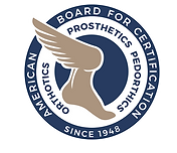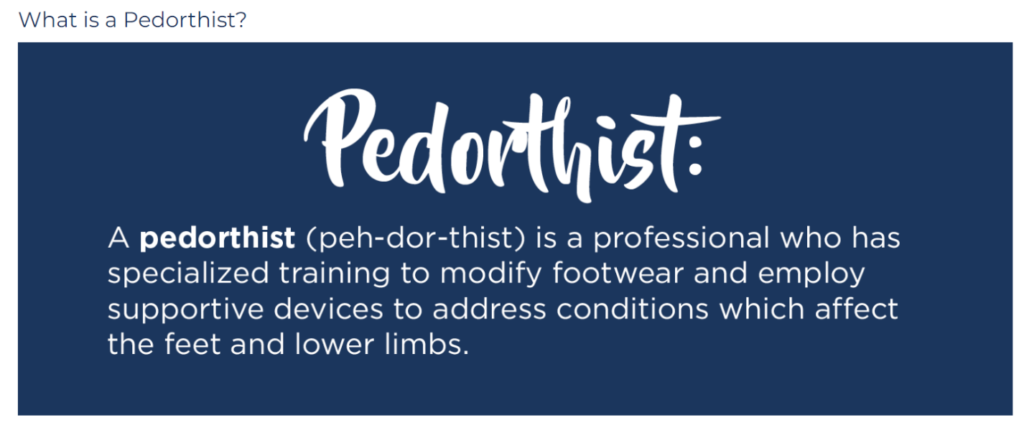About
Welcome
BA Pedorthic Services
About us
BA Pedorthic Services offers pedorthic services. Certified Pedorthists specialize in using footwear which includes shoes, shoe modifications, foot orthosis and other pedorthic devices – to solve foot and lower limb problems. Certified pedorthists understand the properties of footwear and the interaction between the person’s foot and shoe. C. Peds are skilled at evaluating feet and custom fitting footwear. They can provide orthotics that can accommodate, support or relieve specific conditions as well as improve the foot’s function.
Orthotics may be beneficial for treating the effects of a wide variety of foot conditions, including:
- CONDITIONS TREATED
- Arthritis
- Achilles Tendonitis
- Bunions
- Hammertoes
- Flat Feet
- High Arches
- Morton’s Neuroma
- Metatarsalgia
BA Pedorthic Services
Best Services
BA Pedorthic Services offers pedorthic services. Certified Pedorthists specialize in using footwear which includes shoes, shoe modifications, foot orthosis and other pedorthic devices – to solve foot and lower limb problems.
Custom Foot Orthotics
Improve foot functions
Custom Foot Orthotics are prescribed, custom-made devices that can be inserted into a shoe to support, align, prevent and/or accommodate foot irregularities and improve how the foot functions.
Bhavin Amin Pedorthic Services
Bhavin Amin completed his education in lower extremity anatomy, pathology, biomechanics, gait analysis, as well as shoe construction and modification at Kennesaw State University uniquely partnered with Academy of Pedorthic Science – Foot Solutions, Inc in Atlanta, GA, USA in 2020.
He is currently board Certified Pedorthist by the American Board for Certification in Orthotics, Prosthetics, and Pedorthics.
He is Certified Pedorthist from Pedorthist Footcare Association Canada since 2023 and licensed to practice in Canada.



VARIOUS FOOT CONDITIONS & ORTHOTICS
Plantar Fasciitis
The plantar fascia is a dense, fibrous membrane which forms a strong mechanical tie between the heel and toes. The plantar fascia maintains the arch of the foot.
Plantar Fasciitis refers to the inflammation of the plantar fascia and usually occurs due to repetitive stress. It is most commonly seen in people who are active in walking, standing and especially running. Occasionally, Plantar Fasciitis occurs in people who have had an acute injury to the area, a change in footwear, or a change in weight. The plantar fascia is sometimes pulled away from the bone and the body will deposit bone to repair the area. The bone deposit or heel spur is often seen on an x-ray and is a sign of the underlying problem.
Plantar Fasciitis, also known as heel pain syndrome, is the inflammation of the plantar fascia. It usually starts as a dull, intermittent pain in the heel area and may progress to a sharp, constant pain. Typically, Plantar Fasciitis pain is worse in the morning or during the first few steps of an activity and may ease initially and then worsen throughout the day.
Signs and Symptoms
- Heel pain and/or arch pain, especially when first standing after a period of rest
- Swollen heel
- Bony spur on x-ray
Contributing Factors
- Heel pain and/or arch pain, especially when first standing after a period of rest
- Swollen heel
- Bony spur on x-ray
Metatarsalgia
Metatarsalgia (met-uh-tahr-SAL-juh) is a condition in which the ball of your foot becomes painful and inflamed. You might develop it if you participate in activities that involve running and jumping. There are other causes as well, including foot deformities and shoes that are too tight or too loose.
Although generally not serious, metatarsalgia can sideline you. Fortunately, at-home treatments, such as ice and rest, often relieve symptoms. Wearing proper footwear with shock-absorbing insoles or arch supports might prevent or minimize future problems with metatarsalgia.
Symptoms
Symptoms of metatarsalgia can include:
- Sharp, aching or burning painin the ball of your foot — the part of the sole just behind your toes
- Pain that worsenswhen you stand, run, flex your feet or walk — especially barefoot on a hard surface — and improves when you rest
- Sharp or shooting pain,numbness, or tingling in your toes
- A feeling ofhaving a pebble in your shoe
Symptoms
Sometimes a single factor can lead to metatarsalgia. More often, several factors are involved, including:
- Intense training or activity. Distance runners are at risk of metatarsalgia, primarily because the front of the foot absorbs significant force when a person runs. But anyone who participates in a high-impact sport is at risk, especially if your shoes fit poorly or are worn.
- Certain foot shapes. A high arch can put extra pressure on the metatarsals. So can having a second toe that’s longer than the big toe, which causes more weight than normal to be shifted to the second metatarsal head.
- Foot deformities. Wearing too-small shoes or high heels can cause your foot to be misshapen. A downward-curling toe (hammertoe) and swollen, painful bumps at the base of your big toes (bunions) can cause metatarsalgia.
- Excess weight. Because most of your body weight transfers to your forefoot when you move, extra pounds mean more pressure on your metatarsals. Losing weight might reduce or eliminate symptoms.
- Poorly fitting shoes. High heels, which transfer extra weight to the front of your foot, are a common cause of metatarsalgia in women. Shoes with a narrow toe box or athletic shoes that lack support and padding also can contribute to the problem.
- Stress fractures. Small breaks in the metatarsals or toe bones can be painful and change the way you put weight on your foot.
- Morton’s neuroma. This noncancerous growth of fibrous tissue around a nerve usually occurs between the third and fourth metatarsal heads. It causes symptoms that are similar to metatarsalgia and can also contribute to metatarsal stress.
Bunions
A bunion is a bony bump that forms on the joint at the base of your big toe. It occurs when some of the bones in the front part of your foot move out of place. This causes the tip of your big toe to get pulled toward the smaller toes and forces the joint at the base of your big toe to stick out. The skin over the bunion might be red and sore.
Wearing tight, narrow shoes might cause bunions or make them worse. Bunions can also develop as a result of the shape of your foot, a foot deformity or a medical condition, such as arthritis.
Smaller bunions (bunionettes) can develop on the joint of your little toe.
Symptoms
The signs and symptoms of a bunion include:
- A bulging bump on the outside of the base of your big toe
- Swelling, redness or soreness around your big toe joint
- Corns or calluses — these often develop where the first and second toes rub against each other
- Ongoing pain or pain that comes and goes
- Limited movement of your big toe
Contributing Factors
There are many theories about how bunions develop, but the exact cause is unknown. Factors likely include:
- Inherited foot type
- Foot stress or injuries
- Deformities present at birth
Achilles Tendinitis
Achilles tendinitis is an overuse injury of the Achilles (uh-KILL-eez) tendon, the band of tissue that connects calf muscles at the back of the lower leg to your heel bone.
Achilles tendinitis most commonly occurs in runners who have suddenly increased the intensity or duration of their runs. It’s also common in middle-aged people who play sports, such as tennis or basketball, only on the weekends.
Most cases of Achilles tendinitis can be treated with relatively simple, at-home care under your doctor’s supervision. Self-care strategies are usually necessary to prevent recurring episodes. More-serious cases of Achilles tendinitis can lead to tendon tears (ruptures) that may require surgical repair.
Achilles tendinitis is an overuse injury of the Achilles (uh-KILL-eez) tendon, the band of tissue that connects calf muscles at the back of the lower leg to your heel bone.
Achilles tendinitis most commonly occurs in runners who have suddenly increased the intensity or duration of their runs. It’s also common in middle-aged people who play sports, such as tennis or basketball, only on the weekends.
Most cases of Achilles tendinitis can be treated with relatively simple, at-home care under your doctor’s supervision. Self-care strategies are usually necessary to prevent recurring episodes. More-serious cases of Achilles tendinitis can lead to tendon tears (ruptures) that may require surgical repair.
Symptoms
The pain associated with Achilles tendinitis typically begins as a mild ache in the back of the leg or above the heel after running or other sports activity. Episodes of more-severe pain may occur after prolonged running, stair climbing or sprinting.
You might also experience tenderness or stiffness, especially in the morning, which usually improves with mild activity.
Contributing Factors
Achilles tendinitis is caused by repetitive or intense strain on the Achilles tendon, the band of tissue that connects your calf muscles to your heel bone. This tendon is used when you walk, run, jump or push up on your toes.
The structure of the Achilles tendon weakens with age, which can make it more susceptible to injury — particularly in people who may participate in sports only on the weekends or who have suddenly increased the intensity of their running programs.
Corns and calluses
Corns and calluses are thick, hardened layers of skin that develop when your skin tries to protect itself against friction and pressure. They most often develop on the feet and toes or hands and fingers. Corns and calluses can be unsightly.
If you’re healthy, you need treatment for corns and calluses only if they cause discomfort. For most people, simply eliminating the source of friction or pressure makes corns and calluses disappear.
If you have diabetes or another condition that causes poor blood flow to your feet, you’re at greater risk of complications from corns and calluses. Seek your doctor’s advice on proper care for corns and calluses if you have such a condition.
Symptoms
You may have a corn or a callus if you notice:
- A thick, rough area of skin
- A hardened, raised bump
- Tenderness or pain under your skin
- Flaky, dry or waxy skin
Contributing Factors
Pressure and friction from repetitive actions cause corns and calluses to develop and grow. Some sources of this pressure and friction include:
- Wearing ill-fitting shoes.Tight shoes and high heels can compress areas of your feet. When footwear is too loose, your foot may repeatedly slide and rub against the shoe. Your foot may also rub against a seam or stitch inside the shoe.
- Skipping socks.Wearing shoes and sandals without socks can cause friction on your feet. Socks that don’t fit properly also can be a problem.
- Playing instruments or using hand tools.Calluses on your hands may result from the repeated pressure of playing instruments, using hand tools or even writing
Shin Splints
The term “shin splints” refers to pain along the shin bone (tibia) — the large bone in the front of your lower leg. Shin splints are common in runners, dancers and military recruits.
Medically known as medial tibial stress syndrome, shin splints often occur in athletes who have recently intensified or changed their training routines. The increased activity overworks the muscles, tendons and bone tissue.
Most cases of shin splints can be treated with rest, ice and other self-care measures. Wearing proper footwear with custom made orthotics and modifying your exercise routine can help prevent shin splints from recurring.
Symptoms
If you have shin splints, you might notice tenderness, soreness or pain along the inner side of your shinbone and mild swelling in your lower leg. At first, the pain might stop when you stop exercising. Eventually, however, the pain can be continuous and might progress to a stress reaction or stress fracture.
Contributing Factors
Shin splints are caused by repetitive stress on the shinbone and the connective tissues that attach your muscles to the bone.
Morton’s neuroma
Morton’s neuroma is a painful condition that affects the ball of your foot, most commonly the area between your third and fourth toes. Morton’s neuroma may feel as if you are standing on a pebble in your shoe or on a fold in your sock.
Morton’s neuroma involves a thickening of the tissue around one of the nerves leading to your toes. This can cause a sharp, burning pain in the ball of your foot. Your toes also may sting, burn or feel numb.
High-heeled shoes have been linked to the development of Morton’s neuroma. Many people experience relief by switching to lower heeled shoes with wider toe boxes alongwith custom made foot orthotics. Sometimes corticosteroid injections or surgery may be necessary.
Symptoms
Typically, there’s no outward sign of this condition, such as a lump. Instead, you may experience the following symptoms:
- A feeling as if you’re standing on a pebble in your shoe
- A burning pain in the ball of your foot that may radiate into your toes
- Tingling or numbness in your toes
Contributing Factors
Morton’s neuroma seems to occur in response to irritation, pressure or injury to one of the nerves that lead to your toes.
Overpronation
When the arch of the foot collapses excessively downward or inward, this is known as overpronation. Sometimes, people call this condition flat feet.
The way a person’s foot strikes the ground can have significant effects on their body. People with flat feet or who overpronate may be prone to more injuries than people with normal pronation.
Over-pronation is when the arches of the foot roll inward or downward when walking, and is often referred to as flat feet.
Pronation refers to the foot’s natural way of moving from side to side when a person walks or runs.
It occurs as the weight is transferred from the heel to the ball of the foot as a person goes through their walking or running stride.
Pronation also occurs while standing, and in this case, pronation refers to the amount that the foot rolls inward toward the arch.
Some pronation is normal. Overpronation is when the foot rolls inward toward the arch excessively and can cause various injuries.
Symptoms
Many people who overpronate know they have flat feet without seeing a doctor.
If a person thinks they may overpronate, then they can self-assess first using one of the three following methods:
- They should first look at their feet while standing. If there is no clear space between the foot and the floor where the arch should be, the person likely overpronates.
- If a person is a runner, they can check the state of their running shoes. If the majority of the wear is on the inner part of the running shoes, they are likely a person with overpronation.
- They can also check their footprint after taking a few steps with bare, wet feet. A person with normal pronation will see their heelprint connected to the toeprints with about half of their foot width. A person who overpronates will see their heelprint connected with the full width of their foot.
Contributing Factors
Overpronation is generally caused by flat, very flexible feet.
Sometimes, people are born with flat feet. However, there are also conditions and situations that can increase a person’s chances of developing flat feet or weakened arches, which can lead to overpronation.
These conditions and situations include:
- being pregnant
- being overweight or obese
- taking part in any activity, such as running, that involves repeatedly striking the foot on a hard surface for an extended period
Knees Misalignment
Many of us suffer from chronic pain in the knees, hips or lower back. Often, there is a connection between these complaints and the way you walk. This article sheds more light on knee pain and in particular how abnormal foot mechanics or asymmetry in our gait can affect knee function, causing pain and discomfort.
Symptoms
“A sharp pain in the knee and a grinding sensation, especially when getting up out of chair or walking up stairs.“
This description of knee pain is most common and refers to a condition called Patello-femoral Syndrome. Patello-femoral Syndrome is the most common form of chronic knee pain. It refers to pain occurring between the knee cap (the patella) and the underlying thigh bone (the femur). Patello-femoral Syndrome causes pain and tenderness in the front of the knee. The pain gets worse when you sit for a long period and get up. Or when you walk up stairs. Often, one will experience a grinding or crunching sensation in the knee.
Contributing Factors
There are number of different causes for knee pain. With age wear and tear occurs in the knee joint. Also over-use causes knee problems (for example in rugby/football players, and in tradespeople such a carpenters, bricklayers etc). Over time softening of the cartilage beneath the knee cap (the patella) will result in tissue breakdown and pain in the knee joint.
Instead of gliding smoothly over the knee, the knee cap grinds against the thigh bone when the knee moves. In turn this may result in heavy erosion of the cartilage. Apart from age and over-use, the third most common cause of knee pain is faulty gait (i.e. the way we walk). Overpronation (=rolling inwards of the feet and lowering of the arches) is a major contributing factor to knee pain.
